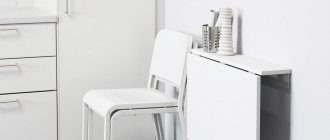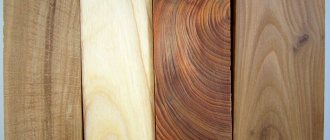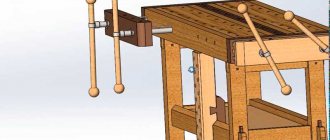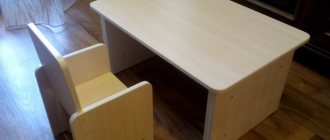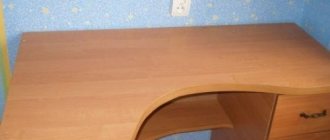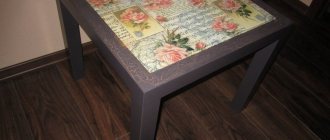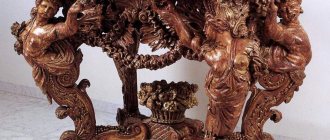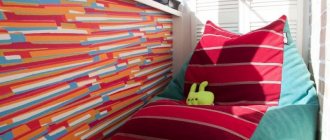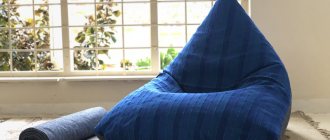Details of cabinet furniture and their names
The main details of cabinet furniture are quite easy to remember, the names of the furniture parts speak for themselves, these are the sides, bottom, lid or tabletop, back wall, drawer or plinth, and in some cases shelves, doors, also known as facades, drawers, dryers, handrails and things like that.
The parts are divided into two main types: the first type is the parts that form the furniture frame, the second type is those furniture parts that are installed directly on the already assembled frame. As an example, let's look at what parts a kitchen table consists of. The parts that form the frame of the furniture in this case are the sidewalls (No. 1), the back wall (No. 2), the drawer or base (No. 3) and the bottom (No. 4), it is also worth noting the important role of the tabletop (not shown in the figure) in this design it must be rigidly fixed either to dowels or to corners. In our case, the additional parts installed on the assembled furniture frame are the remaining doors (no. 5), shelves (no. 7) and drawers (no. 6).
And, by the way, if the desire to acquire new furniture is due only to the desire to update the kitchen, although the old one is functionally satisfactory, it’s probably worth thinking about changing only the hanging parts of the facades, handles and other things. Functionality is another matter - here it’s worth thinking about a complete remodel or adding some furniture elements.
Let's return to the topic of frame furniture details and consider the features of each of them.
Detail of cabinet furniture - Sidewall.
The length and width of the sidewall determine the height and depth of your table, and while you can experiment with depth, an incorrectly selected table height can make it extremely uncomfortable. Among the design features, it is worth noting the need to cut off the corner in the far lower corner of the sidewall, otherwise the table will rest against the baseboard, which will not allow you to move the table close to the wall.
Detail of cabinet furniture - Back wall.
Typically made from fiberboard or treated fiberboard. The width of the back wall is made three millimeters less than the width of the table and, when fastening, they retreat approximately one and a half millimeters on each side. The height of the back wall of the kitchen table should also be shorter, but by 1 - 2 millimeters from the edge of the bottom to the tabletop (there is no need to cover the space behind the console with the back wall). In the lower part you also retreat from the edge of the bottom, but in the upper part it is advisable to make it flush with the sides. The back wall is attached to the furniture parts using ordinary small nails (like post nails), take my word for it - this fastening is enough.
Detail of cabinet furniture - drawer, console.
In most cases, the height of this part is approximately 10 cm. This size of the furniture is due to the fact that the drawer, together with the back wall, prevents our structure from diagonal deformation (in other words, it does not allow it to fall on its side). The width of the console is equal to the width of the table minus the thickness of the two sides. The console is attached tightly between the sidewalls; it is advisable to use Confirmat furniture screed for fastening. In many designs, the drawer is installed flush with the doors, which in my opinion is wrong because when approaching the table you will constantly rub your shoes against the drawer, so it is worth recessing it somewhat inside the table. Installing a drawer at the bottom of the table is traditional, but not at all necessary, so the following figure shows the use of a drawer in place of the console, which can either be attached to the sides or have its own wheels; in the latter case, it is possible to store heavier things or, for example, potatoes. The console in this design is installed at the top of the table.
Detail of cabinet furniture - bottom.
The detail is simple but irreplaceable. The dimensions of the bottom correspond to the depth of the table and the width minus the thickness of the two sides. The bottom is tightly fastened between the sidewalls; it is advisable to use Confirmat furniture screed for fastening.
Details of cabinet furniture - doors.
Doors, or facades, are a separate big topic that we will talk about next time. In this case, we will only touch on the dimensions of the door. The width of the door corresponds to half the width of the table minus five millimeters. (4 millimeters on the edges (2 mm on each side) and one millimeter on each door for the gap between them). The height of the door depends on the presence of drawers in the design, in the presence of which it is necessary to take into account a gap of 2 millimeters with the mating parts of the furniture.
Details of cabinet furniture - drawers and shelves.
Everything is simple with the shelves; their size corresponds to the size of the bottom. It is advisable to attach it to corners, furniture dowel dowels or special holders for shelves. Boxes are a kind of separate design and therefore we will devote a separate topic to them.
In this case, we have not considered all the details of cabinet furniture, but only the main ones, which I hope will be enough to assemble furniture with your own hands for your home and garden.
Source: ptexpert.ru
Types of tables
In furniture showrooms today you can see a wide variety of this item. They differ not only in design and materials, but also in functionality, type of finish, purpose and other features. Each person can choose from a huge number of models what suits his taste.
The following types of tables are considered popular:
- dining;
- serving;
- dining room;
- writing;
- magazine;
- toilet;
- computer and others.
IMPORTANT. In addition to those widely used, there are also special products for tennis, billiards, and models for telephones, TVs or computers. All of them help organize space and save space in the room.
Dining
This species is large in size. Designed to gather guests or the whole family for lunches and dinners, as well as various holidays and events. Typically, standard models of kitchen tables are 80x120 centimeters; it can be moved against the wall, thereby saving space in the kitchen. However, if the product is round or oval in shape, you will have to install it in the middle of the kitchen, which will lead to a reduction in usable area. That is why such dining products have become increasingly installed in private houses or apartments with a large area. In typical apartment buildings, where kitchens are not large in size, modern transformers are more suitable.
Transformable tables
Folding kitchen furniture models are a compact product that can significantly save space in the kitchen. When assembled, they usually measure 85 cm wide and 24 cm deep. When the table is disassembled, it turns into a full-fledged dining room that can accommodate up to 10 guests. Today, designers offer a huge number of modern models, which are distinguished by the convenience of the mechanism, the reliability of fastening and the speed of installation. Also on sale are the familiar “books,” the tabletops of which fold out to the sides. They are not original and are already quite outdated.
IMPORTANT. The most vulnerable point of “transformers” is considered to be the fastenings. Their strength and reliability should be assessed in the store at the selection stage. You should calculate the expected load, taking into account what the guests will lean on the table.
Experts recognize the most reliable models with retractable metal legs. But even such products can become loose over time and become unusable for their intended purpose.
Coffee tables
The main difference between this species and others is their height. They are below the standard value. There are generally accepted sizes, according to which a coffee table is made up to 60 cm high; it is comfortable to sit at it only on a small pouf or in a low chair, up to 42 cm high.
In addition to standard small models of such products, there are also very low tables, slightly raised above the floor. By standard, they have a long tabletop. Such tables are suitable for interiors designed in oriental style. Low cushions are used for seating. The coffee table should fit harmoniously into the existing interior of the living room. It is the central piece of furniture that is always paid attention to first. Therefore, the concept of the overall style of the room should be consistent in this interior detail.
Brief outline of the history of furniture development
Buffet (French) – a cabinet for storing dishes, table linen, snacks, drinks.
Bureau (French) - a type of desk with a retractable lid and drawers for storing papers. Depending on the purpose, there are office bureaus, supplier bureaus, secretary bureaus, and closet bureaus.
Hanger - a shelf or rack with hooks or pegs (as well as a separate hook) for hanging dresses and hats.
Showcase (French) – a glazed box, cabinet for displaying museum exhibits.
Wardrobe (French) – a wardrobe for clothes.
Sofa (pers.) – a type of furniture of large size, soft, semi-soft and hard, for sitting and lying.
Table size
For comfort and ease of use of the table, its certain dimensions must be maintained:
- for the convenience of sitting at the dining table, its height is made 72–78 cm;
- a comfortable stay at a computer desk is achieved with a height of 75 cm;
- a desk requires sitting at it for a long time; it is most convenient to do this at a height of 70–80 cm;
- The kitchen table is also designed for a comfortable position during lunch; a height of 75–76 cm will help ensure comfort.
The tabletop can have different dimensions. It all depends on the amount of free space and the preferences of the home owners. The main thing is that there is enough space to carry out your plans.
Furniture dowel
This type of fastening is rarely used on its own in the modern furniture industry. It is mainly used only to impart rigidity in conjunction with eccentric couplers.
Its main function in most cases of furniture construction is to prevent the panels from moving relative to each other and giving additional rigidity to the fastening.
Usually used in conjunction with an eccentric coupler. It is made from hard natural wood and has a cylindrical shape. This is a very simple and cheap part that has been used in wooden joints since time immemorial.
Craftsmen and carpenters who work with wood use furniture dowels as the main fastening element. In this case, the furniture parts are connected to dowels, which are glued to the parts using PVA glue. In this case, using any other screeds together with PVA no longer makes sense.
The choice is small - the material
In stores you can buy interesting tables made of stone, metal, plastic and glass. All these materials require skills, so wood is still the most favorite - it is environmentally friendly, easier to process, and fits perfectly in almost any interior.
Each tree species has its own characteristics, which must be taken into account. In the furniture industry they often use:
- Birch. Its strengths are strength, resistance to cracking and deformation. The Achilles heel is the fear of permanent humidity, which causes wood to rot. This weakness is eliminated by antiseptic treatment.
- Beech. The material is easy to work with and pliable, although it is a hard rock. Not so resistant to deformation when drying out. Rotting is also a defect that can be eliminated by treating with antiseptics.
- Oak is a beautiful wood; it is distinguished by its noble texture, special strength, and much greater resistance to decay than its previous representatives.
- Spruce is a knotty wood. When processed, it exhibits a tough temperament and becomes capricious when soaked in antiseptic.
- Larch. It is durable and can resist deformation and rotting. The downside is that it tends to crack and is not suitable for rooms where there are frequent changes in temperature and humidity.
- Aspen. Easy to process, does not crack, and almost does not rot. The disadvantage is that it is soft, leading to mechanical damage even from a pencil or pen.
- Fir is a good material for amateurs, as it is easy to process. Fir products are very susceptible to moisture, so they are not suitable for outdoor furniture.
- Pine. It is distinguished by its lightness, but strength, softness and pliability. The deformation is insignificant and can be treated well with antiseptics.
Despite the fact that soft woods promise easy work, it is better to choose a harder material. Among the favorites are beech, oak, larch, and pine. With them, a novice carpenter can be sure that his first table will become a reliable, durable piece of furniture.
Screw tie
The screw coupler consists of a screw and a barrel. This kit is used to attach the end of one panel to the face of another. For example, for attaching a shelf to a side panel or a headboard to the drawers.
This is a very strong fastening due to the large tightening stroke. The only drawback of this fastener is that the screw head is visible from the front of the panel.
You can, of course, close them with special plugs, but this is also not a panacea. The plugs on the outer panel of the cabinet do not look aesthetically pleasing.
Installation of this type of fastener requires skills. Beginners may encounter such a problem as inaccurate alignment of the barrel holes with the hole in the end of the shelf, and it is not so easy to remove the unwanted barrel from its nest.
But the inconvenience during assembly and aesthetic errors are more than compensated for by the reliability and durability of the connection.
Modern types of furniture fasteners
Specialized departments offer many types of furniture fasteners. Almost all of them belong to the same type, this is a threaded screw. The design consists of a wide bolt and nut. During the assembly process, they tightly fix the various parts together. They are used to make kitchen tables, cabinet and upholstered furniture.
The main requirement of such components is their aesthetic appearance. In simple terms, they should be invisible against the general background of the structure. High-quality furniture paraphernalia should not have any defects on its surface.
In addition, other types of fasteners are available for sale. These include:
- bolts with driven nuts. The main advantage of such products is their reliability. The product is strong;
- confirmation It belongs to the screw type of fastener. The principle of operation resembles self-tapping screws or a hex screw. These products ensure quick assembly of the furniture structure, as well as its aesthetic appearance;
- eccentric couplers. Almost all high-quality products consist of such elements. They provide good fixation of each part. In addition, they allow you to increase the speed of assembly;
- wooden corners. This type was used more than ten years ago, but due to their reliability they are used for the production of modern furniture.
The stores offer a catalog of furniture fasteners. It concentrates more than 100 types of metal products for the production of one or another type of furniture paraphernalia.
Conical coupler
The conical tie is often used for fastening thick chipboard panels (25 mm, 38 mm) and assembling frame facades on tie bars.
One of its advantages is the absence of visible caps on the front side of the panels. Unlike the screw in a screw tie, the rod used in a tapered tie is screwed into the panel. The screed itself has 2 holes. One is for the rod, which is screwed into the panel layer. The second is for the conical tie screw. The disadvantage of this type of fastener is the small tightening stroke. Under heavy loads, the holes for the rod screw may become loose over time. Then the screed will simply stop working!
Euroscrew
This fastener is often used for assembling kitchen furniture modules and in economy class furniture. Just like with a screw tie, Euroscrew heads or plugs are visible on the front side of the side panel of the cabinet.
It screws into the end of the shelf with a pre-drilled hole. This screed also belongs to the economy class. To install it, 2 holes are drilled - into the end of the shelf and into the face of the part. They are attached perpendicular to each other. The most commonly used euroscrews are 7 mm in diameter and 50 or 70 mm in length.
This screed has 2 significant drawbacks:
Firstly, the outer side of the cabinet, if there are many shelves behind it, as a rule, is all “disfigured” with caps or Euroscrew plugs. Therefore, these fasteners are used in economy furniture. In kitchens, this drawback is hidden thanks to the cabinets standing in a row.
Secondly, furniture assembled with euroscrews cannot be disassembled and reassembled more than 3 times, since screwing the tie into the end of the shelf destroys its internal structure.
Creating a sketch and drawing
It is necessary to distinguish between the concepts of sketch and drawing. At the first stage, a sketch of the table is created - a drawing that will display all the features of the future furniture (shape, color, finish). You can do it manually. An alternative is to use graphic editors, including online services. Based on the sketch, a drawing of a wooden table is created.
Drawing of a dressing table for making it yourself, stages of work
If you want to make furniture completely yourself, you should arm yourself with paper, a ruler, a pencil and an eraser. Or use online services if special programs are not installed on your computer. Before starting modeling, you need to carefully study the design features of the selected model - what elements it consists of, where and how to connect the parts, how difficult the table is to manufacture. The last point is important, since the level of complexity of the work must correspond to experience, the availability of the necessary tools, fasteners and consumables.
To create the correct drawing and detailing for it, you need:
- determine all the dimensions of the table;
- take into account the thickness of the materials;
- calculate the size of each part;
- draw up a schematic representation of the structure to scale, indicating the dimensions, not forgetting to subtract the thickness of the timber or board;
- separately create drawings of the fastening points of the elements;
- draw up a map of cutting and drilling materials.
To some, such work may seem unnecessarily complicated. In this case, it is easy to find ready-made drawings. They, like step-by-step assembly diagrams, are traditionally posted on thematic online resources.
Based on standard models, exclusive versions of tables are also created, taking into account the design features.
Eccentric coupler
One of the most popular types of fasteners today. All high-quality furniture is assembled on an eccentric screed (minifix). Its operating principle is as follows: an eccentric rod is screwed into the face of the part to which another panel will be attached at the end, into which the eccentric itself is screwed through the end of the other shelf, and then the eccentric turns the rod into itself.
An eccentric tie is always used in conjunction with a wooden dowel, which was described earlier. The dowel provides additional rigidity to the assembly and prevents the fixed panels from moving relative to each other.
Furniture assembled on this screed can be disassembled and assembled an unlimited number of times! There are different diameters of the eccentric itself: 25, 15, 12 mm. More common is an eccentric with a diameter of 15 mm.
Since the eccentric itself is visible on the side panel, plugs are provided for it to match the color of the panel. One of the disadvantages is the weakening of the tie in the event of spontaneous rotation of the eccentric.
To avoid this, some hardware manufacturers have provided notches directed in the opposite direction from its rotation during installation, which enhances adhesion.
Types of eccentric couplers
As practice shows, furniture is assembled and disassembled with great difficulty if all the fasteners in it are metal ties, described above. Let’s say that in order to remove one shelf, you practically need to disassemble half the cabinet. For horizontal parts (shelves), it is more convenient to use eccentrics, which allow you to place horizontal parts in an already assembled furniture box. Their operating principle is the same as that of the previously described eccentric coupler.
The only difference is that the eccentric, located in the shelf, fits onto the rod screwed into the face of the sidewall from above and there is no need to disassemble half the cabinet for this. In some factories, this type of fastener is called a shelf holder, since it is intended only for horizontal parts. Horizontal shelves assembled using these ties further tighten the joint, which increases the rigidity of the entire furniture frame.
Repeated dismantling and installation of furniture on such fasteners does not lead to wear of the connections.
Source: dd-space.com
Doors
Cabinet sliding wardrobes are equipped with sliding sliding panels in the front part. Such designs are convenient in small rooms to save space. Owners of modern spacious apartments prefer to build wardrobes along the entire wall. In this case, a continuous facade of a large area is formed.
A free-standing wardrobe or china cabinet is equipped with hinged doors. The part is intended to protect the internal contents and for decorative purposes. Door fasteners are selected depending on the type: hinged hinges or roller guides.
Facade
As a rule, wardrobe doors form the entire façade of the furniture. Other design solutions for the facade also include:
- fragments of decorative glazing;
- edges of open shelves;
- sheflots (front parts of drawers);
- decorative overlays (horizontal and vertical);
- cornices.
The concept of “façade” includes all visible elements extending into the side or frontal plane. The material, color and texture of the facade sets the style of the interior. It is possible to make sliding wardrobes from ready-made facades, which are sold in a wide range.
Back wall
The back wall covers the product from the back. The materials used are durable boards without decorative finishing: chipboard, HDF, DFPO.
If you need a service for making custom-made furniture in Moscow, you can contact our company. The website contains numerous photographs of models that we will produce according to individual sizes. We offer competitive prices for materials, fittings and work. The surveyor's visit is free.
Source: www.shkaflon.ru
Accessories
Furniture fittings are all kinds of fasteners, handles, curtains, supports and decorative elements. They are made of metal, wood, plastic and other materials. Metal products are treated with special anti-corrosion agents to extend their service life. For luxury-class designs, the fittings can be gold-plated or silver-plated, as well as trimmed with rhinestones, crystal or natural stones. Conventionally, fittings can be classified by type.
Connecting fittings – connects and fixes parts together. This group includes one-piece, detachable and movable elements:
- Permanent connections include screws, ties, screws, nails, bolts, brackets, hooks, upholstery buttons of upholstered furniture. The tie can be eccentric or connecting. Galvanized steel is used for the eccentric tie and makes it durable. The corner tie does not require additional holes in the ends of the furniture. Threaded ties include a nut and a screw that create a strong connection. A wedge coupler is also used for quick connection. It is based on plates, wedges and staples. The ties are connected with traditional screws;
- Detachable connections ─ these are door handles, latches, shelf holders, magnetic devices, locks, bolts. To fasten detachable structures, screws and self-tapping screws are used;
- Movable ─ these are hinges, “rails” for parallel movement of the door, microlifts. Pneumatic mechanisms and ball-bearing guides take on the entire load.
For furniture made from chipboards, it is not recommended to use piano hinges, which were used several decades ago. Today, manufacturers use four-joint designs called "frog". They can withstand a 10,000th door opening/closing cycle.
Rotating elements ─ these include carousel mechanisms, structures for moving tabletops apart, for directing the movement of products. For example, the shelf rotates along its axis and makes it easy to get the desired item. Basically, furniture structures are built using guide systems, which are used to pull out elements. They can extend fully or partially. Thanks to special rollers, such systems operate smoothly and almost silently. They are made of steel, fluoroplastic or duralumin. If we consider the importance of fittings as a percentage of the cost of cabinet, upholstered and kitchen furniture, we get the following results: in cabinet furniture, fittings account for 10-15% of the total cost of the product. For a kitchen, the importance of fittings is 25% of the cost of the set, and for upholstered furniture it is 30-40% of the cost of the product.
Accessories for assembly ─ when purchasing furniture, you need to pay attention to the accessories and upholstery fabric, determine their quality and strength. And also on the assembly details of the product, which include furniture corners, confirmants, rafixes, minifixes and dowels:
- Furniture corners are simple, cheap and affordable types of connections. On the construction market they are presented in different sizes, made of plastic and metal. Corners are designed for fastening hinged parts in pencil cases and cabinets. They are easy to install, have a low price, but are noticeable, which slightly spoils the design of the structure;
- Confirmat is a furniture European screw, which received its name from the German manufacturer. A furniture screw tie, consisting of a steel rod with a blunt ring, a head and a massive thread, is capable of connecting several wooden elements at once. The confirmation is visible in the design, so it is masked with a plug. The most common are screws with dimensions of 7x50 mm or 6.3x50 mm;
- A dowel is a connecting element that is used for assembling wooden, plywood, and chipboard furniture parts. It is made of hardwood and has a cylindrical shape with chamfers. Today plastic dowels are also produced. They strengthen furniture connections with confirmat, minifix and rafix. Used with PVA glue as an independent fastening element;
- Minifix ─ is an eccentric coupler for furniture joints, consisting of two parts ─ a rod and an eccentric. Minifix has a different design, which makes it possible to increase the length of the element and connect it at different angles. For installation, use a Ø15 mm cutter and drills, with which three holes are drilled. The fastening turns out to be complex and requires precise calculation;
- Rafix ─ is used in visible places to connect furniture parts of tabletops, side parts of furniture structures. It is installed on two holes, has an eccentric mechanism and a rod. Rafix has a beautiful aesthetic appearance, but it is not particularly durable.
Source: mblx.ru
Step-by-step work algorithm
Regardless of whether the master is going to make a table from timber, boards or solid wood, oval or square, with 4 or 2 legs, the algorithm will be similar. The first stage is cutting all the necessary parts. Since the drawing with the dimensions of each element is already ready, you can begin making a wooden table with your own hands. If the legs are planned to be metal, the best option would be a steel or aluminum pipe of a suitable cross-section. But the easiest way is to make table legs from timber with your own hands. For this purpose, you will need a block with a cross-section of at least 5 × 5 cm. It is even easier to find ready-made balusters.
The second element is the tabletop. When talking about how to make a wooden table with your own hands, we can mention different shapes and types of tabletops. The easiest way is to make it rectangular or square. They use boards, timber, solid wood, even tree cuts, glass, and other decorative materials. The main thing is to cut them to one size and fasten them together - most often, special glue and wooden dowels are used for this.
At this stage, it is important to remember the strict sequence of actions:
- manufacturing, fitting of all elements;
- sanding;
- opening with soil;
- grinding.
At the second stage we assemble the table. To do everything correctly yourself, you need to adhere to a certain scheme:
- The legs are fastened in pairs with transverse boards, using screws and glue;
- fix pairs of legs to long crossbars;
- Use screws to connect the frame and tabletop.
Making a table for a laptop with a cooling system with your own hands
The last stage is finishing. The DIY wooden dining table is almost ready. All that remains is to give it a beautiful appearance. You immediately need to hide all fastening points using a special putty for wood. It is applied so that the composition completely covers the recesses, leveling the surface. Then everything is sanded and brought to perfect smoothness using a grinder.
Next is the application of paints and varnishes. Those who know how wooden tables are made will name many types of coverings. This is a colorless or tinted varnish (acrylic, solvent-soluble), paint, oils, waxes. Stain does not lose popularity, after processing which the surface is covered with a transparent varnish. It is better to apply coatings to the tabletop with a brush.
To give the table surface special decorative effects, use epoxy resin and lay out a mosaic of glass, ceramics or other materials.
Cutting parts
Fitting elements
Making a countertop
Making legs
Installing the feet
Assembling a single structure
Painting parts
Ready table
